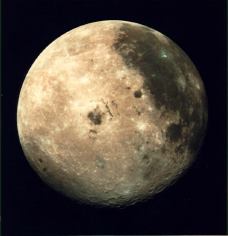
The moon in ancient Greece – A photograph of the moon from space
The goddess Artemis
Early Greeks thought of the moon as the goddess Artemis. Where the Egyptians had thought of the moon as a man and the sun as a woman, the Greeks reversed that and thought of the moon as a woman.
The moon in ancient Greece
By the Archaic period, however, educated Greek men and women knew from observing solar eclipses and ships sailing to the horizon that the moon was a round ball. The astronomer Thales in the 600s BC also knew that the moon didn’t make its own light, but shone by reflecting light from the sun. In the 400s BC, Greek scientists like Anaxagoras knew why eclipses happened.

The Greek goddess Artemis – the moon goddess
The moon goes around the earth
By the Hellenistic period, in the 200s BC, Aristarchus figured out that the moon went around the earth, and (based on the work of the Libyan Eratosthenes) about how big the moon was.
Bibliography and further reading about the moon in ancient Greece:
Greek and Roman Science, by Don Nardo (1998). Nardo has written a lot of good books about the ancient world for kids; this one is no exception.
Greek Astronomy, by Thomas Heath (1932). A collection of what ancient Greek writers had to say about astronomy, in their own words, with a long introduction. For adults.
The History & Practice of Ancient Astronomy, by James Evans (1998). Includes both the history, and directions to actually re-do the experiments that ancient Greek astronomers used to figure out their conclusions. For adults.
Greek Science After Aristotle, by G. E. R. Lloyd (1975).